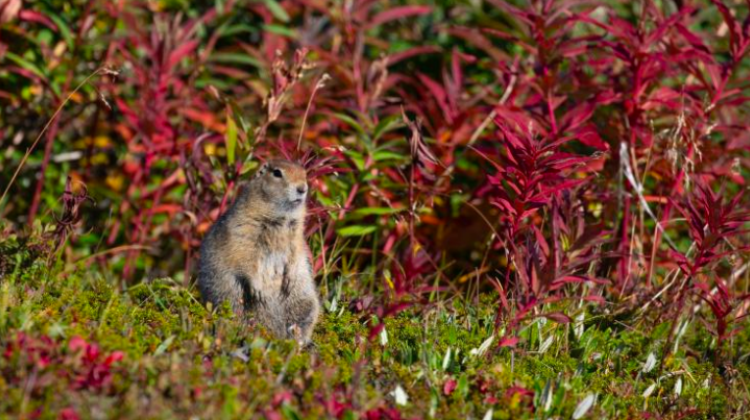Arctic rodent research can help fight malnutrition
 Photo: Fotolia
Photo: Fotolia
The Arctic ground squirrel is a rodent that spends most of its life in hibernation. Although it reduces its body temperature by approx. 40°C, it almost does not lose any fat-free mass. Research on its bacterial flora conducted, among others, by a Polish researcher, could help fight malnutrition in humans.
The Arctic ground squirrel is a species of ground squirrel native to the Arctic. Its body length reaches 30-40 cm, and its weight reaches 700-800 g. This rodent is unique for many reasons. Not only does it hibernate for 9 months a year, but it is the only animal that can reduce its body temperature to minus 2.9 degrees Celsius during the winter sleep, although its normal temperature is about 38 degrees.
Because it`s sleep is very long, the plan for months of its activity is extremely tight. "It has only three months to get fat and breed: 25 days of pregnancy, 30 days of lactation and 113 days of returning to the fatty state to be able to hibernate again" - describes Dr. Julita Sadowska from the Department of Animal Ecology, Institute of Biology, University of Bialystok.
She will be leaving for Alaska soon to study the bacterial flora of the Arctic ground squirrel at the University of Alaska Anchorage. Why is this issue so important in the case of the Arctic ground squirrel? It turns out that during hibernation these animals lose only fat, and their fat-free mass mass remains almost unchanged. Researchers believe that this rodent`s protein demand is probably based on the nitrogen released and recovered by the intestinal flora of the Arctic ground squirrel itself.
In this mechanism, some urea (the final product of the transformation of proteins and other nitrogen compounds in organisms) goes through the bloodstream to the digestive tract. If there is a bacterial flora in the digestive tract that can break down urea, it will decompose it into carbon dioxide and ammonia. Nitrogen is released from the latter and bacteria can use it to produce peptides and amino acids.
The UNS - urea-nitrogen salvage mechanism is not new. It occurs in ruminants, for example cows, and other animals the digestive tract of which has a rumen - an organ that is a habitat of various types of microorganisms. Mammals, including rodents and humans, usually do not have a rumen, and most bacteria live in their large intestine. For this reason, it was believed that in non-ruminant organisms UNS did not matter. Meanwhile, the Arctic ground squirrel shows that also in these animals nitrogen can be used to produce amino acids.
Dr. Sadowska explains that this mechanism of obtaining amino acids could be a remedy for malnutrition also in humans. "If such a bacterial flora (that breaks down urea) could be used in humans, for example by adding a bit of it to the normal intestinal flora, then we could recycle our own nitrogen and nitrogen of bacterial origin to produce amino acids and peptides. That would help avoid the consequences of malnutrition" - the researcher describes.
During her research she will check whether during pregnancy and lactation of the Arctic ground squirrel the increased nitrogen demand is largely covered by nitrogen of bacterial origin. "We will check if nitrogen from labelled urea given to animals appears in their tissues, milk" - she describes.
In recent years, the Arctic ground squirrel has become a popular research object for many scientists and a source of quite surprising discoveries. During one of the experiments, researchers determined the number of neurotransmitters in its brain. "This is done by means of microdialysis, during which a probe is inserted into the brain. Normally, an animal will have a scar after this procedure, but Arctic ground squirrels do not have such scars. Almost as if they can regenerate the brain" - says Dr. Sadowska.
In mammals, temporary blood circulation arrest and later re-supplying the tissues with blood results in an injury caused by such hypoxia. Sometimes it even causes death. Meanwhile, this phenomenon does not occur in Arctic ground squirrels. According to the researcher, one can literally cut off the blood supply to the animal`s brain, then restore it, and the Arctic ground squirrel will get up and go, while, for example, a rat would die.
Dr Sadowska admits that she found out about Arctic ground squirrels - her current research object - by chance. In 2015, during a scientific conference, when she was waiting for a bus, Professor Loren Buck sat next to her at the bus stop. "He told me about Arctic ground squirrels, and that was why I started to be interested in them" - she says.
She plans to go to Alaska for twelve months in March 2019 to study Arctic ground squirrels and conduct research at the University of Alaska in Anchorage. She received a scholarship for the trip - PLN 156 thousand - in the Bekker Programme of the National Agency for Academic Exchange. (PAP)
author: Ewelina Krajczyńska
ekr/ agt/ kap/
tr. RL
Przed dodaniem komentarza prosimy o zapoznanie z Regulaminem forum serwisu Nauka w Polsce.















